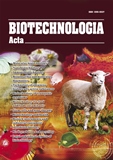ISSN 2410-7751 (Print)
ISSN 2410-776X (Online)

Biotechnologia Acta Т. 17, No. 2 , 2024
P. 81-83, Bibliography 5, Engl.
UDC::616.831-005.1-002.1:616.379-008.64-092.9-07-085
DOI: https://doi.org/10.15407/biotech17.02.081
THE IMPACT OF EDARAVONE ON THE MARKERS OF CARBONYL-OXIDATIVE STRESS IN RATS WITH TRAUMATIC BRAIN INJURY
V.A. TKACHENKO 1, A.I. SHEVTSOVA 2, A.E. LIEVYKH 1, YU.V. KHARCHENKO 1, V.I. ZHYLIUK 1
1 Dnipro State Medical University, Dnipro
2 Oles Honchar Dnipro National University, Dnipro
In the condition of traumatic brain injury (TBI), the brain develops a series of complex metabolic changes, including protein carbonylation, enhanced lipid peroxidation, impaired neurotransmitter release, and imbalanced energy supply, that are associated with the development of different functional disorders so the search for preventive medications in this pathology is very important. Edaravone is considered a supplementary drug in treating different functional disorders of the central nervous system, but the mechanisms of its protective action remain under question.
Aim. This comparative research aimed to study the effects of edaravone on the biomarkers of carbonyl-oxidative stress (COS) in rats with traumatic brain injury. TBI was caused by mechanical damage with a metal weight (450 g) falling from a height of 170 cm.
Methods. Advanced oxidation protein products (AOPP), thiobarbituric acid reactive substances, and protein carbonyls (PC370/PC430) were studied using spectrophotometry in serum and fraction S1 in experimental animals' brain cortex and hippocampus. Edaravone supplementation may provide significant protection against brain hemorrhagic complications by reducing COS and oxidative modification of proteins.
Results. In our study, edaravone demonstrated moderate efficacy in reducing serum PC430 and AOPP levels, indicating its ability to attenuate TBI-induced oxidative damage. In addition to its systemic effects, edaravone exerted targeted effects on COS-modified proteins in the hippocampus, even though such biomarkers were not altered significantly by TBI alone.
Conclusion. Further research is necessary to elucidate this drugs primary mechanisms of action based on the data obtained.
Key words: traumatic brain injury, oxidative modification of proteins, carbonyl-oxidative stress, edaravone.
© Palladin Institute of Biochemistry of National Academy of Sciences of Ukraine, 2024

